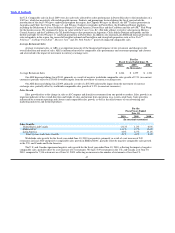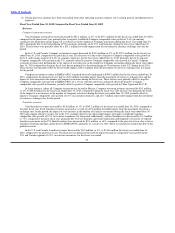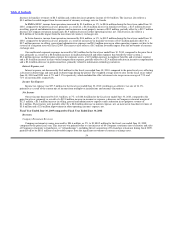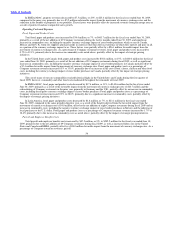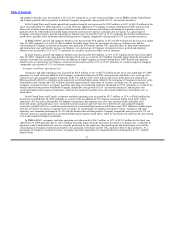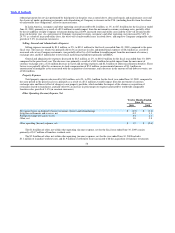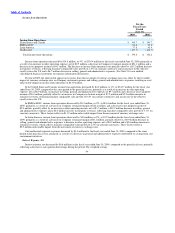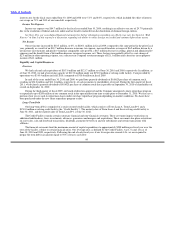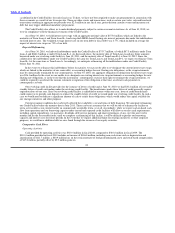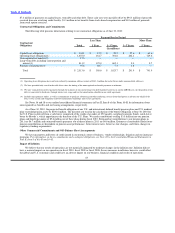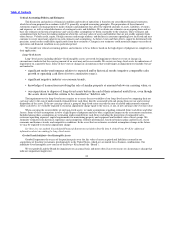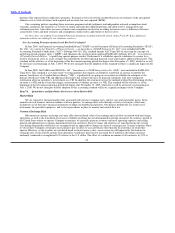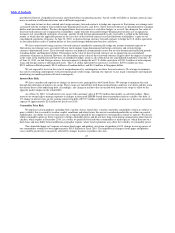Burger King 2010 Annual Report Download - page 59
Download and view the complete annual report
Please find page 59 of the 2010 Burger King annual report below. You can navigate through the pages in the report by either clicking on the pages listed below, or by using the keyword search tool below to find specific information within the annual report.
Table of Contents
and employee benefits costs increased by 1.2% to 31.0%, primarily as a result of increased labor costs in EMEA and the United States
and Canada, partially offset by positive worldwide Company comparable sales growth of 0.3% (in constant currencies).
In the United States and Canada, payroll and employee benefits costs increased by $58.2 million, or 16%, to $414.9 million for the
fiscal year ended June 30, 2009, primarily as a result of the net addition of 59 Company restaurants during fiscal 2009 and increased
labor costs resulting from the negative impact from decreased traffic and increased staffing and training on acquired restaurants,
partially offset by a $6.8 million favorable impact from the movement of currency exchange rates in Canada. As a percentage of
Company restaurant revenues, payroll and employee benefits costs increased by 0.6% to 31.1%, primarily due to labor inefficiencies
noted above, partially offset by benefits derived from positive Company comparable sales growth of 0.5% (in constant currencies).
In EMEA/APAC, payroll and employee benefits costs decreased by $9.8 million, or 6% to $159.9 million for the fiscal year ended
June 30, 2009, primarily as a result of a $16.0 million favorable impact from the movement of currency exchange rates and the
refranchising of Company restaurants in the prior year, primarily in Germany and the U.K., partially offset by government mandated
and contractual wage and benefits increases in Germany. As a percentage of Company restaurant revenues, payroll and employee
benefits costs increased by 2.2% to 32.7%, primarily as a result of increases in labor costs in Germany.
In Latin America, payroll and employee benefits costs decreased by $0.9 million, or 11% to $7.4 million for the fiscal year ended
June 30, 2009, compared to the same period in the prior fiscal year as a result of a $1.2 million favorable impact from the movement of
currency exchange rates, partially offset by the net addition of eight Company restaurants during fiscal 2009. Payroll and employee
benefits costs as a percentage of Company restaurant revenues increased by 0.5% to 12.3%, primarily as a result of negative Company
comparable sales growth of 3.2% (in constant currencies).
Occupancy and Other Operating Costs
Occupancy and other operating costs increased by $18.8 million, or 4%, to $457.8 million for the fiscal year ended June 30, 2009,
primarily as a result of the net addition of 69 Company restaurants during fiscal 2009, increased rents and utility costs, start−up costs
related to new and acquired Company restaurants in the U.S. and the write−off of unfavorable leases in the prior year, primarily in
Mexico, partially offset by a reduction in the amount of accelerated depreciation related to the reimaging of Company restaurants in the
United States and Canada and a $22.4 million favorable impact from the movement of currency exchange rates. As a percentage of
Company restaurant revenues, occupancy and other operating costs remained relatively unchanged at 24.3%, primarily as a result of the
benefits derived from positive worldwide Company comparable sales growth of 0.3% (in constant currencies) and the prior year
accelerated depreciation expense noted above, offset by increased rents and the write−off of unfavorable leases in the prior year, as
noted above.
In the United States and Canada, occupancy and other operating costs increased by $35.7 million, or 13%, to $306.8 million for
the fiscal year ended June 30, 2009, primarily as a result of the net addition of 59 Company restaurants during fiscal 2009, which
represents a 6% increase in the number of Company restaurants in this segment year over year, increased rents and utility costs,
increased repairs and maintenance costs, increased casualty insurance and start−up costs related to new and acquired Company
restaurants, partially offset by a reduction in the amount of accelerated depreciation as noted above and a $5.2 million favorable impact
from the movement of currency exchange rates in Canada. As a percentage of Company restaurant revenues, occupancy and other
operating costs remained unchanged at 23.1% with the benefits derived from positive Company comparable sales growth of 0.5% (in
constant currencies) and the prior year accelerated depreciation expense noted above, offset by increased rents and start−up costs related
to new and acquired Company restaurants.
In EMEA/APAC, occupancy and other operating costs decreased by $16.7 million, or 11%, to $133.2 million for the fiscal year
ended June 30, 2009, primarily due to a $14.4 million favorable impact from the movement in currency exchange rates, a reduction in
payments made to third parties for services currently performed by our employees, decreased repairs and maintenance costs and the
refranchising of Company restaurants in the prior year, primarily in Germany and the U.K., partially offset by increased rents. As a
percentage of Company restaurant revenues, occupancy and other operating costs remained relatively unchanged at 27.3%, with the
benefits from
57


